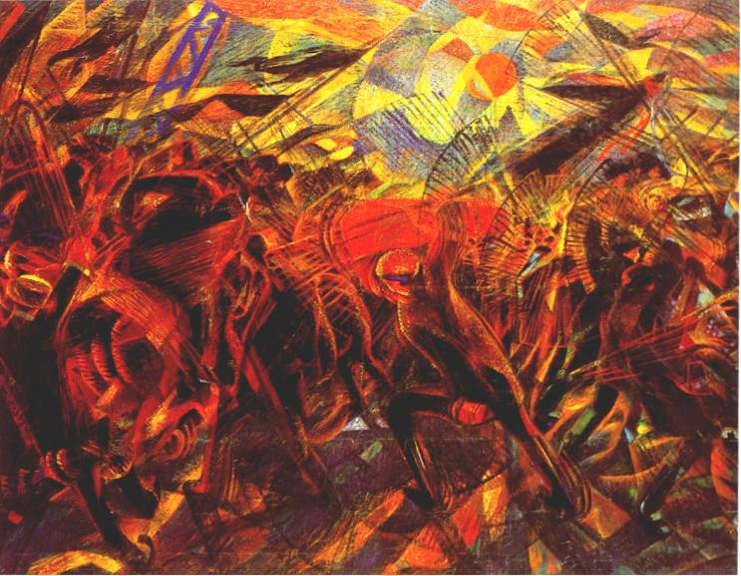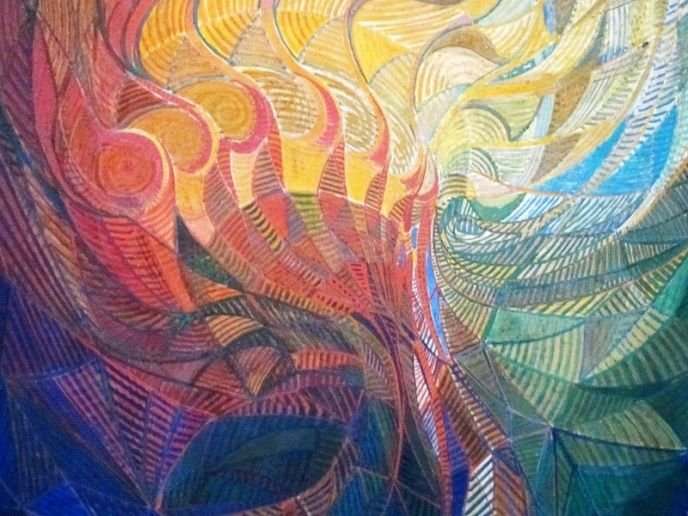Futurism is a trend in modern art that began in the first decade of the twentieth century in Italy. It start with "The Manifesto of Futurism" published by the poet Philippo Tommaso Marinetti in 1909. The Manifesto proclaims a radical denial of traditional cultural values, the destruction of museums, libraries and academies at the expense of new aesthetics based on the dynamics of modern civilization. Futurism is "designed" as an art of the future. It is ideologically related to left-wing movements and fascism. It is supported by a number of manifests. Appears in literature, plastic arts, theater and music. In 1910 appeared a manifesto of futurist artists. It was signed by Umberto Bochoni, Carlo Carra, Gino Severin, Luigi Roussola and Giacomo Bala. Futurism is among the most radical phenomena of the early European avant-garde - an innovative direction denying the past. Futurists see an opportunity for renewal in the absurd of society. New forms of expression are sought, other than the imitation forms characteristic of the past. The artist is sharply opposed to society. Harmony and good taste are rejected, like bourgeois and fake symbols. Futurists say old art must be destroyed. They proclaim the harm of artistic criticism. It is believed that universal dynamism must be recreated as a dynamic worldview. There is a rejection of the story. Futurists explore the successive phases of the movement with the idea of incorporating into the work the fourth dimension - the time.

From a futuristic point of view, futurists focus on modernity - sports, the machine, the car (the machine is one of the main myths of Modernism). Some principles of Cubism and abstract art as well as Expressionism are borrowed formally. A typical eclectic is characteristic. Apart from Italy, futurism is also developing in Russia. Serious influence of the Russian avant-garde makes Marineti's journey to St. Petersburg, but Russian futurism appears regardless of the Italian one. It evolves primarily in poetry and painting, but has also been shown in theater, cinema and other cultural fields. The manifestations of futurism in Russia are largely associated with the cubofuturism trend. This typically Russian avant-garde phenomenon unites within itself the plastic principles of Cubism and the futuristic ideas of object development over time. The Manifesto of Russian Futurists called "Shamar of the Public Taste" was published in 1912 and was signed by Borlyuk, Levsic, Mayakovsky, Hlebnikov, Kandinsky and others. Among the well-known Russian artists who appear in this direction are: K. Malevich, O. Rozanova, N. Goncharova P. Flonov, M. Laryonov and others. Futurism is the first phenomenon that attempts to go beyond the traditional artistic work. Futurists make simultaneous recitations of sound versus poetry; gesture demonstrations and behavioral acts. Behavioral gestures of artists become particularly important. It is assumed that these events are the prototypes of contemporary performances. Some of the futurists make their first attempts to incorporate mechanics and real time into their works, making them precursors to kinetic art. Futurists (as well as Dadaists) take advantage of the opportunities provided by new media such as cinema and photography.

Marinetti sets out briefly the main principles of the futurists, who are possessed by the passionate vileness of the ideas of the past, especially the artistic and political traditions. Marinetti and others are fascinated by love for speed, modern technology and brutal violence. Automobile, airplane, and industrial city acquire mythical features in the futuristic creations as they embody the technological victory of man over nature. Marinetti's passionate ambience immediately attracts around him some young Milan painters - Umberto Bochoni, Carlo Kara and Luigi Roussola - who are taking over Marinetti's ideas in the visual arts / Roussolo is also a composer and introduces futuristic ideas into his musical compositions. Artists Giacomo Bala and Gino Severin will meet Marinetti in 1910. These artists appeared during the first period of futurism.

The artist and sculptor Umberto Bochoni (1882-1916) wrote a Manifesto of Futuristic Artists in 1910 stating: "We want to fight fiercely with the fanatical, unconscious, and snobbish religion, relying on the past, fueled by the disastrous existence of the museums. We are revolting against the exalted admiration of the old sails, the old statues, the old things, and the enthusiasm about everything that is eaten, dirty and worn out of time, and we judge as unjust and criminal the usual disregard for everything that is young , new and loaded with boiling life. Futurists during their presentations and performances, attack you by being physically involved. In other cases, futurists are being attacked by an outrageous audience, as is the case with the presentation of Marinetti's renowned "Veto of the Venetians". The ideological position of the Futurists to glorify war as an expression of the liveliest and purifying impulse of man, asserted by aggressive and persuasive nationalism, brought them after the war to the establishment of a rather problematic relationship with fascism.

To their passion is the cultural ostracism that is subject to post-war futurism, ostracism, which gradually gives way to a less solemn, more relaxed critical position. After the death of Bochonio and Santa Elia, volunteers in the Great War, and after leaving Kara and Severin, the line entered a new period known as Second Futurismo, ending with the death of Filippo Tomazo Marinetti in 1944. Many futurists continue to express themselves in the different arts in the second half of the twentieth century. The December 2004 death of artist Osvaldo Perucci was marked as the death of futurism. The direction of "futurism" has an impact on many artistic movements that emerged in the twentieth century, such as Art Deco, Wortichism, Constructivism and Surrealism. Although futurism has disappeared as a historical phenomenon, its imaginative imagery supports the notion of "metallisation of the human body", which still lives in Japanese culture and is manifested, for example, in the animation / manga / anime / and in the Japanese film Shinya Tsukamoto. The Italian 20-centimeter euro coin depicts Bochon's sculpture "Unique forms in the continuity of space"
So that's where it all started. Thinking what's next seems like natural to us human beings. This makes me wonder too what's next for technology specially with Crypto Market.
For Crypto Market I don't know, but have you watch "Black Mirror"? There are very interesting ideas about the future of the technology. There is episode called "Nosedive" I recommend it to you.
One of the largest museums in Italy and Russia, earns thousands of dollars per day and every day thousands of tourists come here and tourists enjoy many fun and earn a lot of money.
Very nice :)
Yap..@godflesh i look up to many stock photo sales, higher buyer download is mechanism, factory in human live artist ... What influence of topic can be change like that
Great blog... really interesting👍
Thank you :)
Great articles, I wonder which category you would put my art in?
Hm, hard to say... some kind of surrealism and dadaism? Just remind me in some way of that:
Thanks :D
You got a 9.20% upvote from @postpromoter courtesy of @godflesh!
Want to promote your posts too? Check out the Steem Bot Tracker website for more info. If you would like to support the development of @postpromoter and the bot tracker please vote for @yabapmatt for witness!